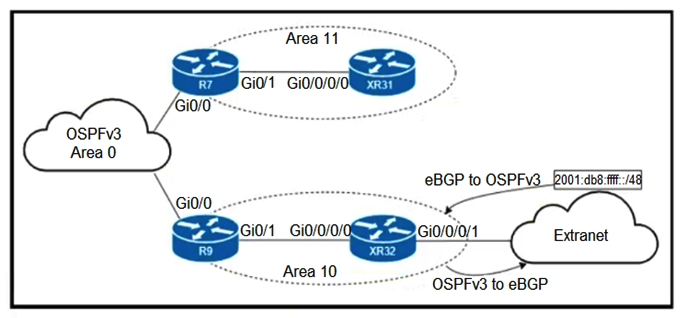Multiple Choice
 Refer to the exhibit. An engineer is updating this network to meet these conditions: Area 10 will receive inter-area routes and support mutual redistribution of external routes with the extranet. The ::/0 route is prohibited in Area 10. Area 11 will receive only the ::/0 route from the ABR. External route redistribution is not supported in Area 11. The ABR in Area 11 will advertise no interarea routes. Which two configurations must be performed to meet the requirements? (Choose two.)
Refer to the exhibit. An engineer is updating this network to meet these conditions: Area 10 will receive inter-area routes and support mutual redistribution of external routes with the extranet. The ::/0 route is prohibited in Area 10. Area 11 will receive only the ::/0 route from the ABR. External route redistribution is not supported in Area 11. The ABR in Area 11 will advertise no interarea routes. Which two configurations must be performed to meet the requirements? (Choose two.)
A) Configure area 10 as nssa on R9 and XR32 Configure area 10 as nssa on R9 and XR32
B) Configure area 11 as stub no-summary on R7 and as stub on XR31 Configure area 11 as stub no-summary on R7 and as stub on XR31
C) Configure area 11 as nssa no-summary on R7 and as nssa on XR31 nssa no-summary
D) Configure area 11 as nssa default-information-originate on R7 and as nssa on XR31 nssa default-information-originate
E) Configure area 10 as stub on R9 and XR32
Correct Answer:

Verified
Correct Answer:
Verified
Q106: <img src="https://d2lvgg3v3hfg70.cloudfront.net/C1178/.jpg" alt=" Refer to the
Q107: An engineer is setting up overlapping VPNs
Q108: Which configuration modifies Local Packet Transport Services
Q109: <img src="https://d2lvgg3v3hfg70.cloudfront.net/C1178/.jpg" alt=" Refer to the
Q110: Which configuration mode do you use to
Q111: <img src="https://d2lvgg3v3hfg70.cloudfront.net/C1178/.jpg" alt=" Refer to the
Q112: A network engineer must enable the helper
Q113: Why do Cisco MPLS TE tunnels require
Q114: An engineer needs to implement QOS mechanism
Q115: BGP has been implemented on an IOS